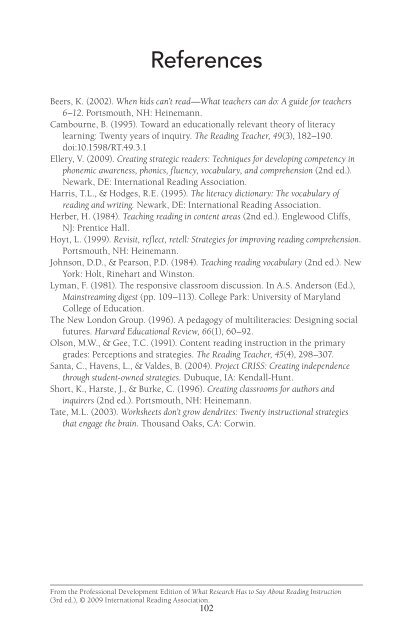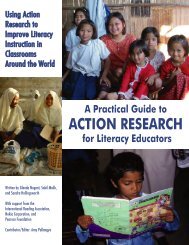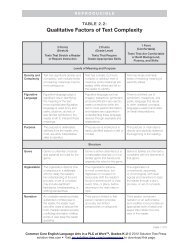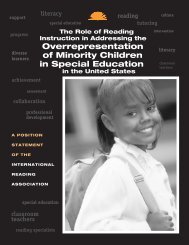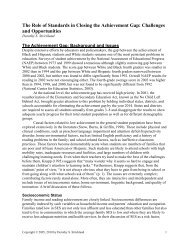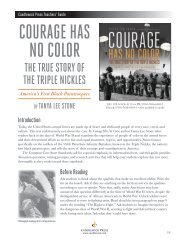What Research Has to Say About Reading Instruction - International ...
What Research Has to Say About Reading Instruction - International ...
What Research Has to Say About Reading Instruction - International ...
Create successful ePaper yourself
Turn your PDF publications into a flip-book with our unique Google optimized e-Paper software.
References<br />
Beers, K. (2002). When kids can’t read—<strong>What</strong> teachers can do: A guide for teachers<br />
6–12. Portsmouth, NH: Heinemann.<br />
Cambourne, B. (1995). Toward an educationally relevant theory of literacy<br />
learning: Twenty years of inquiry. The <strong>Reading</strong> Teacher, 49(3), 182–190.<br />
doi:10.1598/RT.49.3.1<br />
Ellery, V. (2009). Creating strategic readers: Techniques for developing competency in<br />
phonemic awareness, phonics, fluency, vocabulary, and comprehension (2nd ed.).<br />
Newark, DE: <strong>International</strong> <strong>Reading</strong> Association.<br />
Harris, T.L., & Hodges, R.E. (1995). The literacy dictionary: The vocabulary of<br />
reading and writing. Newark, DE: <strong>International</strong> <strong>Reading</strong> Association.<br />
Herber, H. (1984). Teaching reading in content areas (2nd ed.). Englewood Cliffs,<br />
NJ: Prentice Hall.<br />
Hoyt, L. (1999). Revisit, reflect, retell: Strategies for improving reading comprehension.<br />
Portsmouth, NH: Heinemann.<br />
Johnson, D.D., & Pearson, P.D. (1984). Teaching reading vocabulary (2nd ed.). New<br />
York: Holt, Rinehart and Wins<strong>to</strong>n.<br />
Lyman, F. (1981). The responsive classroom discussion. In A.S. Anderson (Ed.),<br />
Mainstreaming digest (pp. 109–113). College Park: University of Maryland<br />
College of Education.<br />
The New London Group. (1996). A pedagogy of multiliteracies: Designing social<br />
futures. Harvard Educational Review, 66(1), 60–92.<br />
Olson, M.W., & Gee, T.C. (1991). Content reading instruction in the primary<br />
grades: Perceptions and strategies. The <strong>Reading</strong> Teacher, 45(4), 298–307.<br />
Santa, C., Havens, L., & Valdes, B. (2004). Project CRISS: Creating independence<br />
through student-owned strategies. Dubuque, IA: Kendall-Hunt.<br />
Short, K., Harste, J., & Burke, C. (1996). Creating classrooms for authors and<br />
inquirers (2nd ed.). Portsmouth, NH: Heinemann.<br />
Tate, M.L. (2003). Worksheets don’t grow dendrites: Twenty instructional strategies<br />
that engage the brain. Thousand Oaks, CA: Corwin.<br />
From the Professional Development Edition of <strong>What</strong> <strong>Research</strong> <strong>Has</strong> <strong>to</strong> <strong>Say</strong> <strong>About</strong> <strong>Reading</strong> <strong>Instruction</strong><br />
(3rd ed.), © 2009 <strong>International</strong> <strong>Reading</strong> Association.<br />
102


